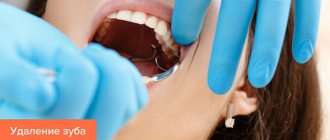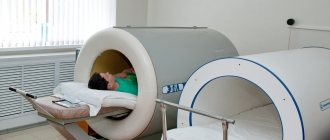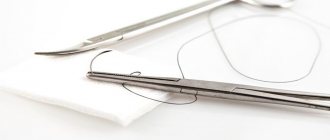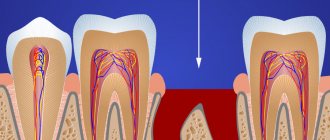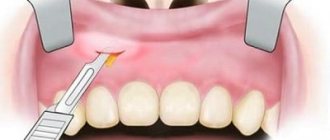If you have wisdom tooth pain, it may be due to:
- the wisdom tooth erupts, which is accompanied by pain in all adjacent tissues;
- caries, periodontitis or pulpitis has developed in the wisdom tooth.
When a wisdom tooth erupts, pain usually always accompanies this process. Most often, pain occurs due to inflammation of the hood located above this tooth. Pain can also be caused by the pressure of the erupting wisdom tooth on other teeth, causing them to shift. Let's take a closer look at what to do in these cases.
Inflammation of the hood over the wisdom tooth
When a wisdom tooth erupts through the mucous membrane and the crown creates one or more bumps, inflammation of the hood occurs. In this case, the chewing surface of the dental crown may already be partially open, but part of it continues to be covered by the mucous membrane. This mucous membrane, which hangs over the crown of the erupting tooth, in this case the wisdom tooth, is called the hood.
Under the surface of this hood, a cavity is formed in which favorable conditions are created for the proliferation of microbes, which is why the inflammatory process begins. Inflammation of the hood has a special name - pericoronitis. Pain in the gum next to the wisdom tooth is usually associated with inflammation of the hood.
What to do if the hood is inflamed? If the inflammation is minor and there is no purulent discharge from under the hood, you can try to cope with the problem on your own, using a combination of antiseptic rinses and anti-inflammatory gels. You can rinse your mouth with a 0.05% chlorhexidine solution or apply Cholisal gel.
It is necessary to treat the oral cavity twice or thrice a day, always after eating and brushing your teeth. You need to rinse your mouth for one minute with a solution of chlorhexidine, which is sold in a pharmacy in ready-made form and costs 20-30 rubles. Then the surface of the hood should be dried using a dry gauze swab, and the gel should be applied to it with your finger. After this, you should not rinse your mouth, and you should not eat for 2-3 hours.
If there is significant inflammation, if pus is oozing from under the hood or there is significant swelling that makes it painful to swallow, you should consult a dentist. Of course, rinses, antibiotics, and anti-inflammatory gels can be used to reduce inflammation, but they can only bring temporary relief, or even not help at all.
To treat such a case, it is necessary to excise the hood, which should not be delayed. The later you decide to undergo this procedure, the stronger the inflammation will be, and the procedure itself will become difficult and unpleasant. But usually this operation takes no more than 5 minutes and is completely easy to tolerate.
Jaw pain after wisdom tooth removal
Natural processes
Even with the so-called “simple” removal of a wisdom tooth, the jaw will inevitably hurt for 5-7 days after this procedure. This is normal, and if the pain causes you severe discomfort, you can take painkillers periodically after consulting with your doctor.
If the removal was “complicated” and involved cutting and suturing the gum tissue, this pain may last a little longer, but, in the end, it gradually goes away.
If after 7-10 days the pain has not gone away, you should definitely consult a doctor, as this may be a sign of a developing pathology, for example, inflammatory processes.
Alveolitis
One of the most common complications after the removal of any tooth, including wisdom teeth, is alveolitis - the development of inflammatory processes in the socket of the extracted tooth due to the fact that a protective blood clot has not formed there.
The main symptom of alveolitis is the patient’s severe pain in the jaw in the area of the extracted tooth. Swelling of the gums, fever and general malaise may also occur.
Wisdom tooth pain
Alveolitis is treated by relieving inflammation. For this purpose, the dentist prescribes special anti-inflammatory drugs, and in some cases, physical therapy.
In no case should you treat alveolitis yourself based on recommendations from friends or the Internet. Incorrect treatment can lead to more serious consequences, including osteomyelitis - inflammation of the jaw bone tissue.
Paresthesia
After a complex wisdom tooth removal, in addition to pain, you may feel numbness in the area of your tongue, lips, and cheeks for some time. This complication is called paresthesia and occurs when nerve endings are damaged during the procedure.
It is treated with therapy with vitamins B and C, as well as injections of dibazole and galantamine. Treatment, again, must be prescribed exclusively by a dentist.
Jaw fracture
If a wisdom tooth is removed in a difficult manner, careless manipulation may result in a fracture of the jaw bone, which will be accompanied by severe pain. This most often occurs when a chisel and hammer are used to “gouge out” a tooth or root.
A fracture caused by tooth extraction is often not immediately recognized. Its symptoms (pain in the jaw, difficulty opening the mouth, discomfort when chewing food) can be attributed to ordinary temporary complications after the procedure. An accurate diagnosis can only be obtained through a thorough examination and a panoramic photograph of the jaw.
Treatment of a jaw fracture consists primarily of transport immobilization (ensuring immobility) of the lower jaw using a chin-parietal bandage. In the future, observation is required in a maxillofacial hospital, where the patient will be prescribed all the necessary procedures and medications.
Dislocation of the lower jaw
This is a “milder” version of jaw injury in the process of wisdom tooth removal compared to a fracture. Most often, a wide opening of the mouth during anesthesia leads to dislocation of the lower jaw, because the wisdom tooth is the last one in the dentition and access to it is limited.
The main symptoms: pain in the ear area, inability to completely close the teeth; in case of unilateral dislocation, the jaw is shifted to the healthy side, in case of bilateral dislocation - forward.
The problem is resolved at an appointment with a dentist, who, using certain manipulations, sets the jaw back into place.
If you have problems with the eruption of wisdom teeth, we strongly advise you not to leave things to chance, but to consult a dentist. The Kornident clinic employs exclusively highly qualified professionals who will be able to remove the wisdom tooth that is bothering you efficiently and with minimal risk of complications and will give recommendations for the rehabilitation period.
When there is not enough space for an erupting wisdom tooth
Quite often there is a situation when the erupting wisdom tooth does not find enough space in the dentition. The tooth strives to make room for itself and tries to displace neighboring teeth. The seventh tooth is located in front of it, which transmits pressure to the sixth and so on. The teeth begin to shift, which causes pain.
What to do in this situation? The most unpleasant consequence is the possibility of crowded teeth. To prevent it, wisdom teeth are often specially removed, and the damaged bite is straightened with braces. It is quite simple to assess the prospect of whether a particular person is likely to develop crowded teeth. It is necessary to correctly assess the lower jaw and its length, assessing whether there is enough space for all the teeth, including the wisdom tooth.
How does the eighth molar make itself known?
- Discomfort when chewing;
- severe pain in the area of molar eruption;
- swelling, redness of the gums;
- inflammation of the submandibular lymph node;
- limited jaw mobility (difficult to even open your mouth);
- painful swallowing;
- deterioration in general health;
- temperature increase.
More often problems arise with the lower eights. The wisdom tooth below hurts more than the erupting extreme molar on the upper jaw. The latter, much less often, grows incorrectly and almost never involves a neighboring unit in the process. This reduces the risk of gum injury and discomfort during teething. The eighth molar on the lower jaw causes more problems. The bone tissue around it often becomes inflamed, causing significant discomfort and pain.
Wisdom tooth caries
The symptoms of this disease are quite characteristic: pain occurs when eating sweet and sour foods, cold and hot. After the irritant stops acting, the pain calms down. The decision whether to treat such a tooth or remove it is made by the dentist, depending on the degree of damage to the tooth and the correctness of its location.
There are times when identifying the cause of pain and the tooth on which its cause is located turns out to be quite difficult. A situation is possible when a wisdom tooth, in the process of erupting, presses its crown onto the adjacent seventh tooth, causing its destruction. The focus of caries may be on the seventh tooth, near the gum itself or even below its surface. The diagnosis of such a situation can only be established using an x-ray, where a similar focus of the disease is observed as a darkening.
How to relieve pain?
At the first unpleasant sensations from a growing wisdom tooth, frequent rinsing with Chlorhexidine, Miramistin or Eludril solution helps. If you can’t run to the pharmacy, you can prepare a soda-salt solution: dissolve 1 teaspoon of soda and salt in one glass of warm boiled water.
Supporters of traditional methods can use oak bark, sage and chamomile. To do this, you need to take 3-4 tablespoons of the mixture, composed in equal proportions, and pour 500 ml of boiling water. Leave for an hour and strain before using.
Rinses are effective only if the pain is caused by the natural process of tooth eruption. All of the listed drugs, both pharmaceutical and home-made, relieve swelling well and suppress the activity of pathogenic microflora in the oral cavity.
If symptoms of an attached infection have already developed: fever, swelling, severe swelling, surgical intervention will most likely be required: removal of either the hood or the tooth itself. In order to reduce the risk of complications, the doctor will definitely prescribe antibiotics.
Please note: it is strictly forbidden to prescribe antibiotics to yourself!
But painkillers should be taken before visiting the doctor. In this case, the following are effective:
- Broad spectrum analgesics
. Analgin, Ketanov, Paracetamol relieve pain for several hours, usually from 1 to 5. It is also possible that the tablet will not work at all. You can increase the dose, the main thing is to strictly follow the instructions. - Anti-inflammatory drugs.
Nurofen, Ibuprofen, Diclofenac can not only provide a powerful analgesic effect, but also relieve fever and reduce swelling. - Ointments, gels, sprays for topical use
. Holisal, Metrogyl Denta, Kamistad, Angilex “freeze” any sensations in the sore gum for 2-3 hours.
An ordinary piece of ice relieves pain well. It needs to be wrapped in a cloth and applied to the external projection of the diseased tooth on the cheek. Hold for no more than 5-7 minutes. Do not put ice directly on the gum. Its tissues are too delicate and direct contact can lead to necrosis.
The most original folk method of getting rid of toothache when a wisdom tooth comes out: take a plantain leaf, wash it and roll it into a tube. Then you need to insert the sheet into the auricle, but always on the side on which the tooth hurts. Dentists call such methods useless. But this method does not cause any harm. So why not try?!
Pulpitis of wisdom tooth
Pain in acute pulpitis is paroxysmal and very sharp. They are spontaneous in nature, arising without any stimuli, completely spontaneously. If caries is accompanied by pain that disappears immediately after the thermal irritant is removed, then pain from pulpitis, even if the irritant is removed, continues for another 10-15 minutes. At night, such pain increases.
Chronic pulpitis of the wisdom tooth is also accompanied by pain, but it is not so pronounced. This is an aching pain that occurs periodically under the influence of a thermal stimulus or cold. 10-15 minutes after eliminating the irritant, the pain calms down. If your wisdom tooth aches, most likely it is pulpitis in its chronic form.
Wisdom tooth periodontitis
Acute periodontitis is accompanied by aching pain, which is clearly felt in the wisdom tooth. If you bite on a tooth, the pain increases sharply. The gum or cheek may be swollen. If pain in the wisdom tooth is accompanied by pain in the gums, the gums next to the tooth are swollen on either side, this may signal the development of an acute form of periodontitis.
Chronic periodontitis often has no symptoms at all. It may only be painful to bite on this tooth or tap on it. But the pain is not severe. A fistula may form on the gum next to the wisdom tooth, from which pus is released in small quantities.






